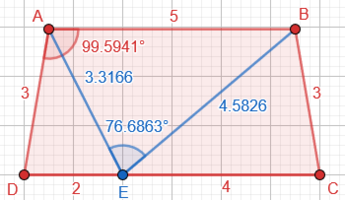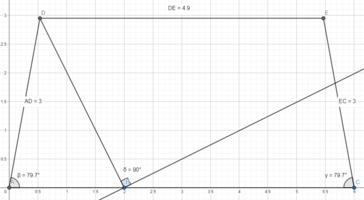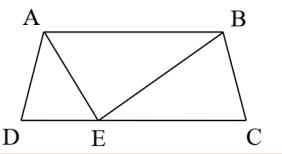pineapplewithmouse
Junior Member
- Joined
- Jun 22, 2021
- Messages
- 63
So I had a math test today, and there was a trig question with a trapezoid.
I couldn't figure out the answer for the question, so after the test I asked my friend what he got, and I used their way of solving the problem to try and solve it, and I got a different answer from theirs. I tried to draw the trapezoid in geogebra, to see which one of us is right, but not only that I couldn't draw the trapezoid with our solutions, I couldn't draw it at all. So I thought, maybe this trapezoid is impossible (or I just can't draw properly), but if so, how can I prove it?
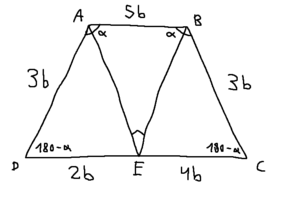
AD=BC=3b
DE=2b
EC=4b
The angle BAD is equal to α (degrees)
And then there are 2 properties that just look like they can not exist together:
AB=1.25EC=5b
The angle AEB is equal to 90 degrees.
This is what my friend did and it seems to work theoretically:
By using the law of cosines in triangles ADE and BCE, you can see the AE is equal to sqrt(13b^2+12b^2*cosα) and BE is equal to sqrt(25b^2+24b^2*cosα).
Then by using the pythagorean theorem in triangle AEB, you get that α=111.17 degrees.
After you find α, the problem tells you that the perimiter of the escribed circle of the trapezoid is equal to 25.
With that information I got that b=1.312, and my friend got b=1.107.
Both options don't seem to work in geogebra as you can see:
b=1.107
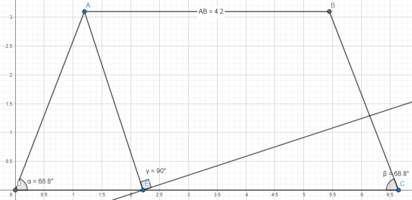
b=1.312
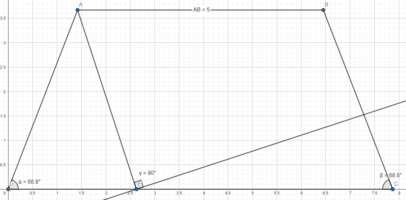
In both cases AB is equal to approximately 3.8b, and AEB is not equal to 90 degrees.
Can I somehow prove that this trapezoid is possible/impossible?
I will really appreciate any help.
I couldn't figure out the answer for the question, so after the test I asked my friend what he got, and I used their way of solving the problem to try and solve it, and I got a different answer from theirs. I tried to draw the trapezoid in geogebra, to see which one of us is right, but not only that I couldn't draw the trapezoid with our solutions, I couldn't draw it at all. So I thought, maybe this trapezoid is impossible (or I just can't draw properly), but if so, how can I prove it?

AD=BC=3b
DE=2b
EC=4b
The angle BAD is equal to α (degrees)
And then there are 2 properties that just look like they can not exist together:
AB=1.25EC=5b
The angle AEB is equal to 90 degrees.
This is what my friend did and it seems to work theoretically:
By using the law of cosines in triangles ADE and BCE, you can see the AE is equal to sqrt(13b^2+12b^2*cosα) and BE is equal to sqrt(25b^2+24b^2*cosα).
Then by using the pythagorean theorem in triangle AEB, you get that α=111.17 degrees.
After you find α, the problem tells you that the perimiter of the escribed circle of the trapezoid is equal to 25.
With that information I got that b=1.312, and my friend got b=1.107.
Both options don't seem to work in geogebra as you can see:
b=1.107

b=1.312

In both cases AB is equal to approximately 3.8b, and AEB is not equal to 90 degrees.
Can I somehow prove that this trapezoid is possible/impossible?
I will really appreciate any help.

